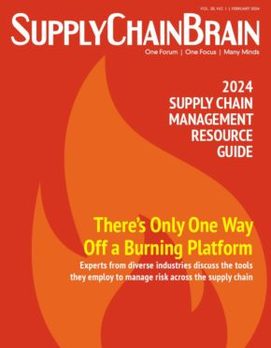
Home » Goodyear's Logistics Outsourcing Program Faces A Moment of Truth
Goodyear's Logistics Outsourcing Program Faces A Moment of Truth

Most growing businesses reach a moment of truth when they must decide how to manage their supply chains. Will they keep on doing it themselves, or outsource the job? Will they rely on multiple providers, or one trusted partner? If just one, how will they make that choice?
For the North American Tire division of The Goodyear Tire & Rubber Co., the moment came in 2002. The company had been working with a variety of logistics vendors, and key decisions on matters such as freight booking were largely decentralized. As a result, Goodyear wasn't getting the leverage that an organization of its size should have when dealing with service providers.
Goodyear took its first tentative steps into outsourcing in the mid-1990s, but its efforts weren't coordinated across the organization. By 2002, the company had built up 22 distribution locations, half of them operated in-house and half by third-parties-five different ones, to be precise. "It became obvious that we were having growing pains," recalls Ted Augustine, director of logistics and product supply for the North American Tire division.
Time to take control of the network. Step one, says Augustine, was to reaffirm Goodyear's commitment to outsourced logistics. Then it took a close look at the company's existing providers, with an eye toward whittling them down to a single trusted partner for all locations.
A comprehensive request for proposals shrank the field to two, then one: Exel plc, the veteran contract-logistics provider with roots in warehousing. (Independent at the time, it recently was acquired by Deutsche Post World Net.) Exel was one of Goodyear's five original providers, managing distribution centers for the company in York, Pa.; Orlando, Fla.; Columbus, Ohio; Memphis, Tenn.; and Victorville, Calif.
At the time of the change, Goodyear cited Exel for its help in improving inventory management, resulting in better cash flow and order fill rates. Augustine praises the vendor for its commitment by all levels of management- "to convert what the strategists are talking about to the people on the floor." Exel's reward was a request that it do more-this time, as Goodyear's lead logistics provider.
Planning Center Launched
The partners moved quickly to solidify their relationship. Together they launched a new load planning center (LPC) at Goodyear's headquarters in Akron, Ohio, staffed full-time by Exel employees. The goal was to centralize all transportation operations across North America. Activities would be overseen by an eight-member steering committee, composed of executives from both companies.
In May 2003, the LPC took over the job of managing the transportation of products originating at the Columbus distribution center. By year's end, it would assume those duties for 20 more Goodyear DCs, giving Exel responsibility for managing 1.5 million tires per week, moved by 120 core carriers and sold to more than 20,000 customers across North America. (With sales of nearly $8bn in 2004, North American Tire accounts for about half the business of Goodyear Tire & Rubber Co.) Most of the distribution locations were shifted over to Exel's control within 90 days. The handover occurred "without a single episode of failure to one of our customers," says Augustine.
Good planning and intensive training were at the heart of the program. Franklin Littleton, Exel's senior vice president of automotive for the Americas, says Exel invested heavily in project oversight, scrutinizing all existing management, equipment and procedures at the various distribution facilities. Many hourly and supervisory workers were invited to remain, although Exel drew on its own employees for key management positions. With Exel's help, Goodyear did more with less. It reduced the network of North American distribution centers from 22 to 17, closing smaller locations and eliminating duplicative tasks.
Supporting the DCs are 13 manufacturing plants, turning out product for passenger cars, trucks, farm equipment, motorcycles, military customers and even go-karts.
Inside the LPC is a transportation optimization system from Manugistics Group Inc. Run by Exel employees, the software controls routing for all freight moving within North America, selecting the most efficient options in terms of both cost and service. Customer needs can vary widely, from the full pallets required by original equipment manufacturers to individual picks for the aftermarket.
Tire warehouses tend to be bound by tradition. They rely heavily on traditional forklifts and pallet jacks, aided by relatively little automation, says Littleton. Goodyear's stocking strategy was equally unyielding, having been in place for nearly eight years.
Slow Movers Transferred
Change was in order. Two years ago, Goodyear and Exel revisited the way in which they were stocking various items based on frequency of orders. The Memphis warehouse was converted into a repository of slow-moving items, the so-called "C's" and "D's." Several thousand SKUs were transferred from other locations into Memphis, freeing up space for "A" and "B" items with faster turnover.
At the same time, the shift built up sufficient critical mass in Memphis so that Goodyear could ship slower-moving product to any part of the country within about three days, Augustine says. Gone was the problem of being short of enough orders to service customers from any one location.
Exel's relationship with Goodyear blossomed into four distinct engagements: fulfillment operations at the various warehouses; management of the LPC, aided by the Manugistics transportation-modeling tool; contract logistics for less-than-truckload deliveries of production materials; and the formation of a supply chain management team to identify operating efficiencies and implement best practices. Beginning with about 15 members, the SCM group was reduced to half a dozen once "the low-hanging stuff" was tackled, says Augustine.
Overall inventory levels are down, due to the new stocking strategy and reliance on a single provider. Goodyear has set a target of improving inventory management by a full two turns. "We're 80 percent of the way there," Augustine says. While he won't divulge specifics, Augustine says Goodyear was "significantly below" the industry's average cost per unit in 2004. Three years earlier, it was at or slightly above that benchmark.
Goodyear hopes to expand its relationship with Exel. One possibility is tapping the provider for a vendor-managed inventory program for raw materials. Another is greater reliance on Exel for worldwide freight forwarding and customs brokerage.
Augustine says Exel could help Goodyear well beyond the confines of North America, in regions such as Europe, Asia-Pacific and Latin America. "North American Tire is half of the company," he says. "There's another 50-percent opportunity in the rest of the world."
RELATED CONTENT
RELATED VIDEOS
Subscribe to our Daily Newsletter!
Timely, incisive articles delivered directly to your inbox.
Popular Stories

2024 Supply Chain Management Resource Guide: There's Only One Way Off a Burning Platform
VIEW THE LATEST ISSUECase Studies
-
Recycled Tagging Fasteners: Small Changes Make a Big Impact
-

Enhancing High-Value Electronics Shipment Security with Tive's Real-Time Tracking
-

Moving Robots Site-to-Site
-
JLL Finds Perfect Warehouse Location, Leading to $15M Grant for Startup
-
Robots Speed Fulfillment to Help Apparel Company Scale for Growth



